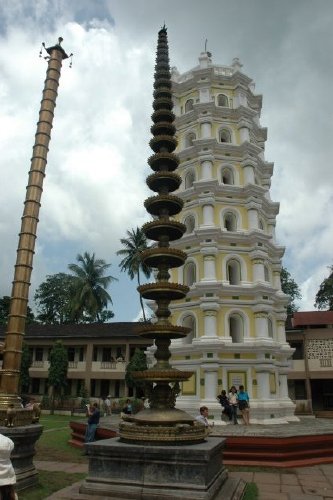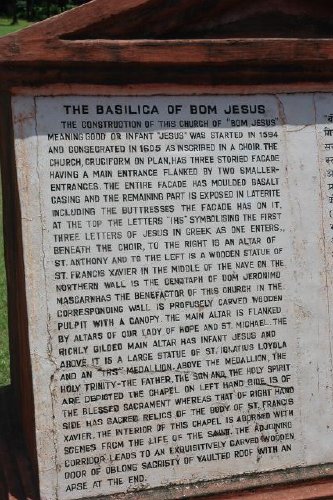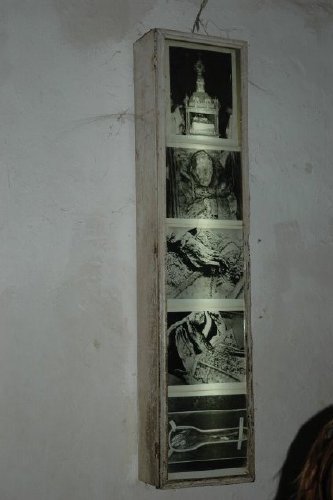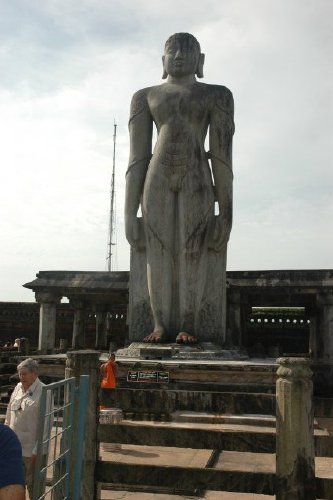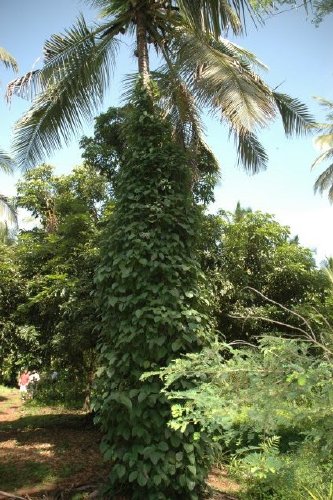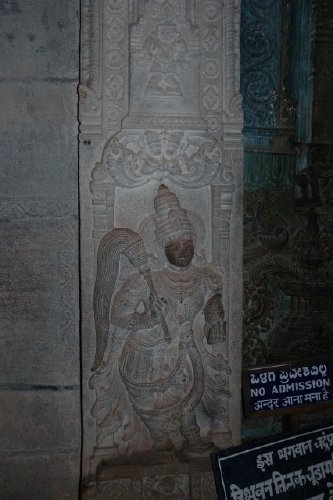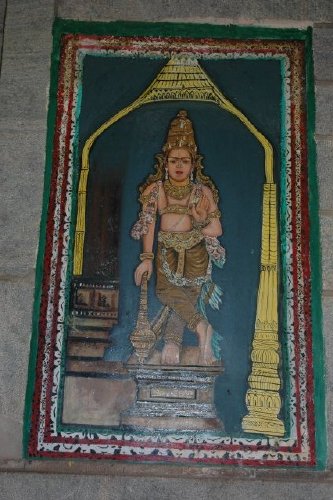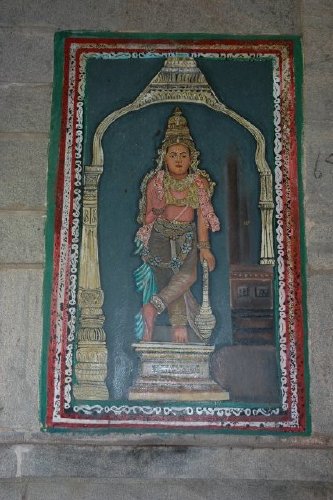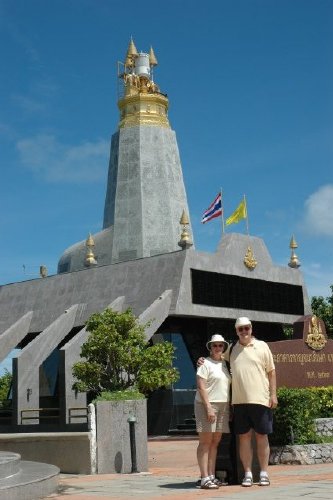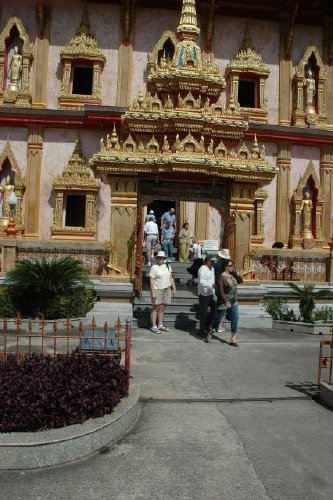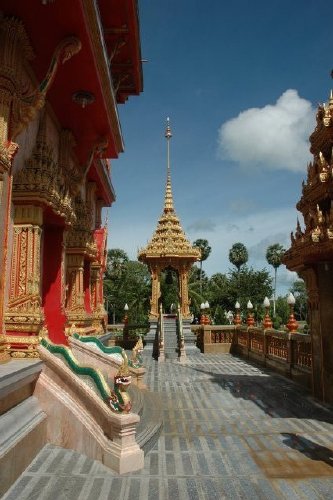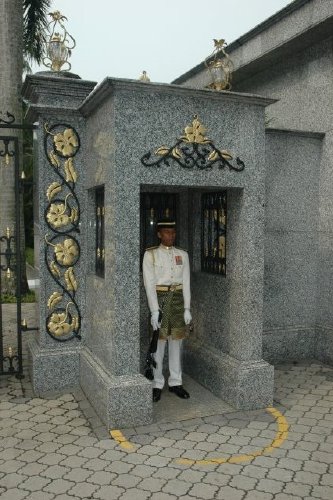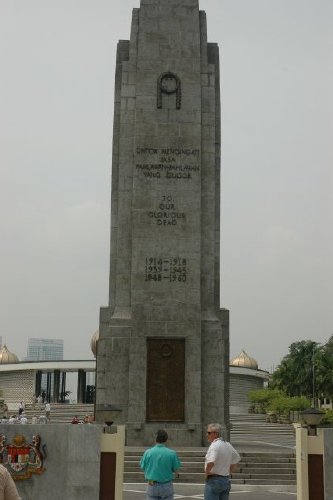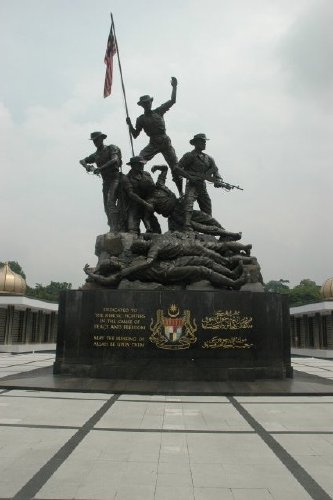ENJOY...
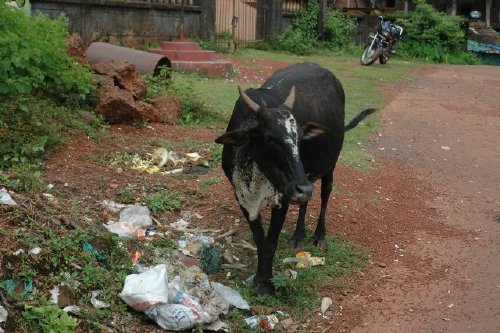 |
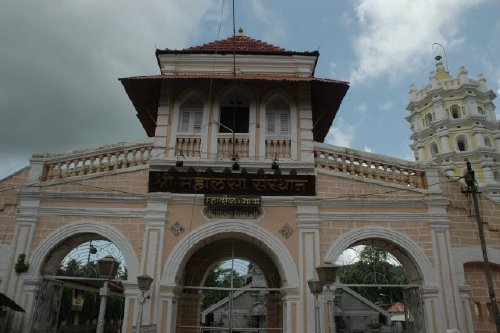 |
A very Hungry cow in Goa, now called Mormugao. You get very tired of the garbage that is thrown all over the place by everyone and then just left for the animals to clean up. Anyway ... history lesson ... Goa was under Portuguese rule for 450 years and was only liberated in 1961 after a little saber rattling. |
Sri Mahalsa
Directly in front of this temple lies a unique lamp tower which is lit during the annual Zatra festival (Feb.). This 12.5 m brass lamp is filled with oil and lit and is known to be the largest in Goa. Vishnu is the deity here. |
 |
|
Typical Princess Tour .. lots of people and you have to make sure you are standing right beside the guide if you hope to hear anything. |
Interesting place to wander, but as usual, all tours leaving the boat seem to end up in the same places at the same time. Add those numbers to the number of independent tourists and the place is crawling |
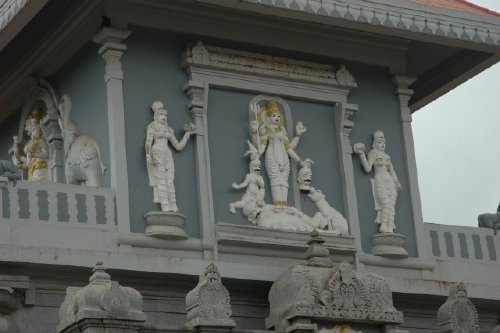 |
 |
Still the decorations and the buildings are really well kept. |
The idea here is to buy flowers as you walk in and place them on a dish as an offering to Vishnu |
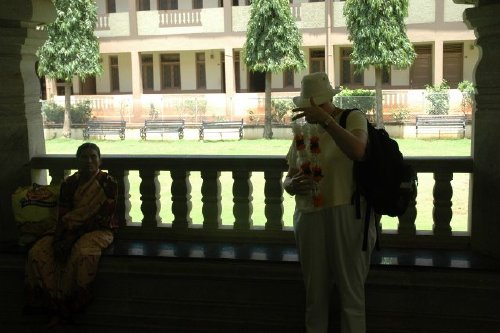 |
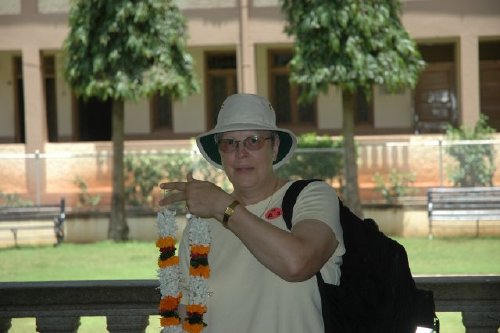 |
Elsie took great care choosing the flowers ... there were lots of them to chose from |
They were real flowers blossoms that were carefully stitched together by the little old ladies sitting there |
 |
 |
The temptation is to take them home ... I thought that I would have a problem with Elsie but she is always full of surprises ... Again, no shoes are allowed |
Solid silver whatsit being explained by the guide |
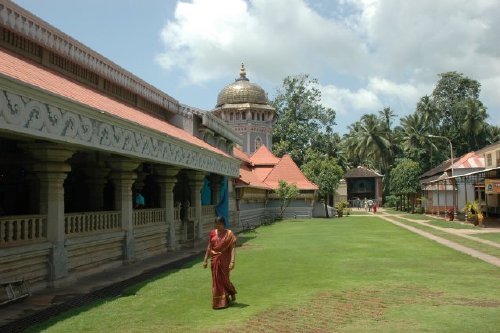 |
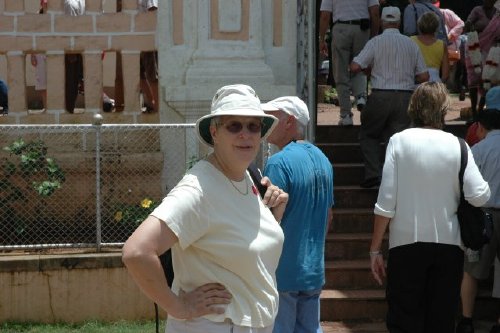 |
This is the site for pilgrimages and just to the left of this shot are rooms for families to stay in when they visit. This lady just left one of these rooms ad was heading to the alter. |
Indiana Elsie on her way out of the Temple ... notice the crowds |
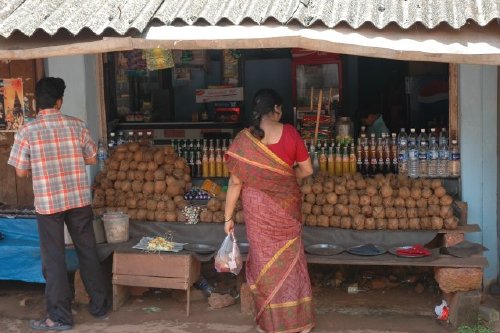 |
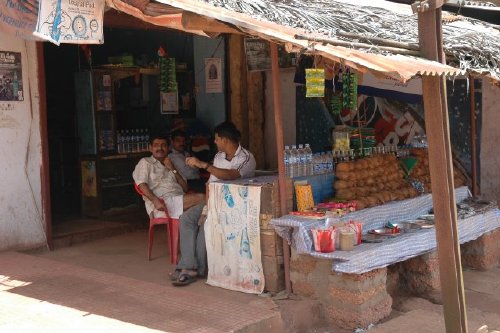 |
Always places to buy fruit and cold drinks. If you can peel it you can eat it and if you open the bottle yourself, you can drink it. |
Very friendly people always ready to say "HI" |
|
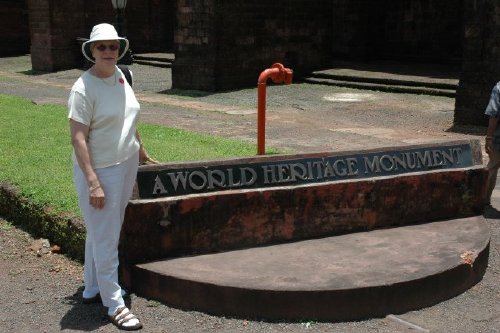 |
The Basilica of Bom Jesus is on one side of the road and the tomb of St Francis Xavier on the other. |
Once again, it is a World Heritage Monument. I don't remember just how many of these monuments we have visited this trip ... but more than a few. |
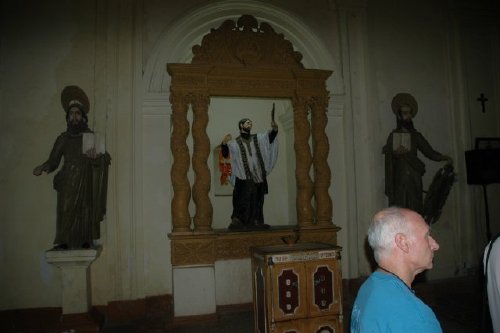 |
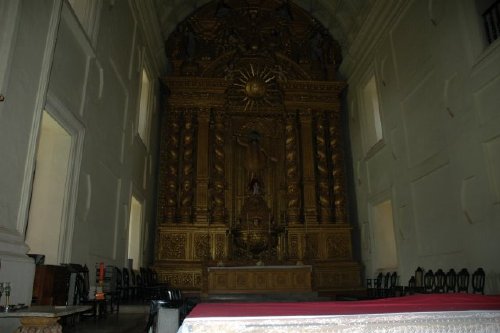 |
A very beautiful building, beautifully kept, nestled in the midst of poverty. Let's hear it for organized religion!!! It doesn't matter which side of the world you are on! |
After this, we crossed the road to the tomb of St Francis Xavier |
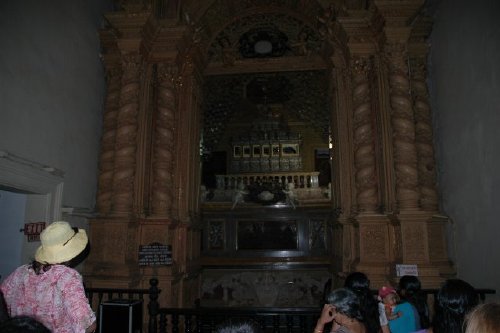 |
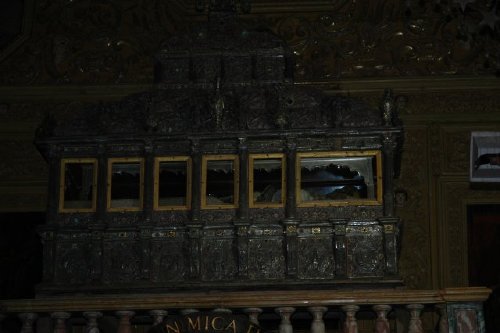 |
St Francis Xavier, who was given the task of preaching Christianity among the subjects of Portugal’s colonies in the Far East during the mid 16th century. After ten years of tireless missionary work, he died on an island off the coast of China and his body was transferred – still in allegedly perfect condition - to Goa. Many people regarded the condition of the body as a miracle, and he was canonized in 1622 – only for parts of the body to be removed and shipped all over South East Asia. By the end of the 17th century the condition of the body had declined terribly, and the Jesuits took the decision to enclose it in a glass coffin out of view. In the mid 19th century, it was decided to expose the corpse once every ten years, a practice which continues until the present day and attracts millions of pilgrims to each event. |
If you look closely, the side glass panels show the body inside |
|
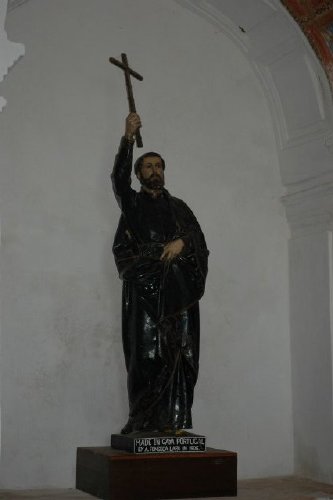 |
This box on the wall, has pictures from the panels in the coffin |
St Francis Xavier |
 |
 |
I love the trees in front of the Tomb. There is no real wind to produce this leaning as you might expect ... they just lean |
Our next stop was a market that encompassed several blocks. We really had fun wandering through here |
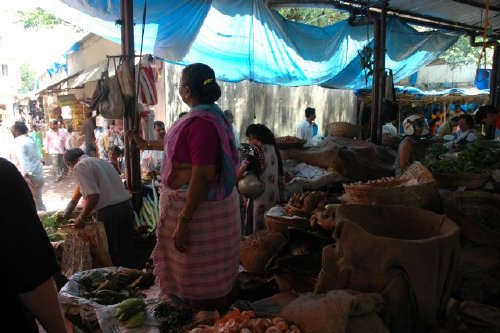 |
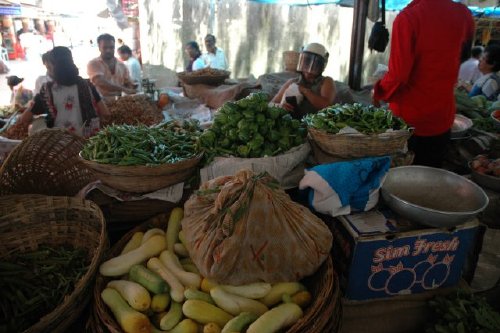 |
Lots of people and lots of things I could not identify |
How do you get vegetables any fresher? |
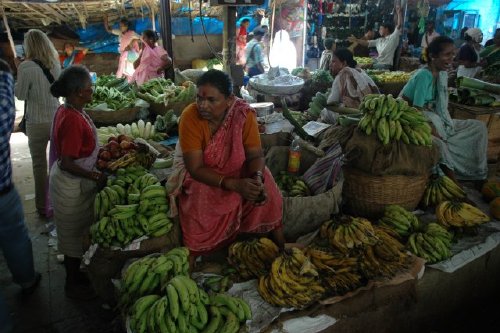 |
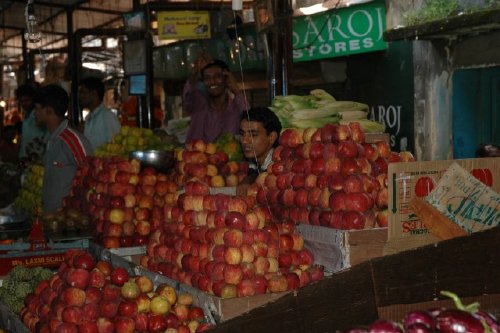 |
Sort of sitting in the middle of all her produce. There was no price on her that I could find |
Apple head??? The people were incredibly friendly and continually waved and said hello |
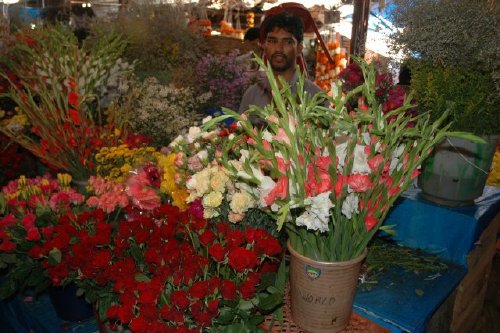 |
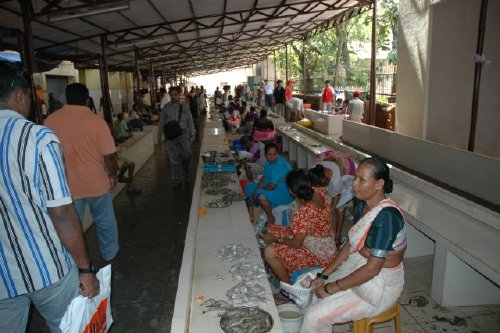 |
The flowers sure are incredible. The prices were sure reasonable not like at home!! |
This is the fish market side. Not much left by the time we got there. |
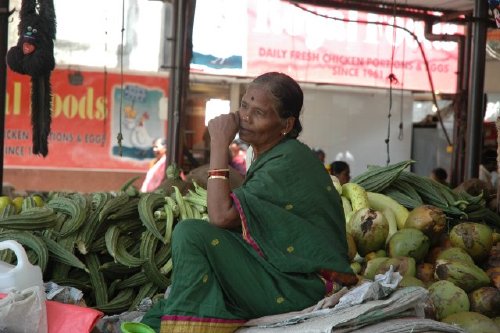 |
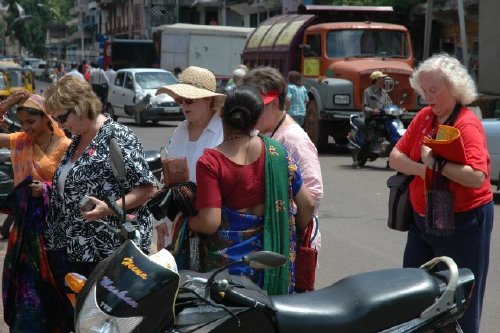 |
It must have been a very long day for her!!!! |
Of course, the inevitable street hawkers selling tacky tourist trash. It is the same the world over ... haggling for junk. Some of the people from the boat sure bought a lot of this stuff ... Buyer's remorse starts when they have to fit all the "precious junk" into their suitcase before they fly home. |
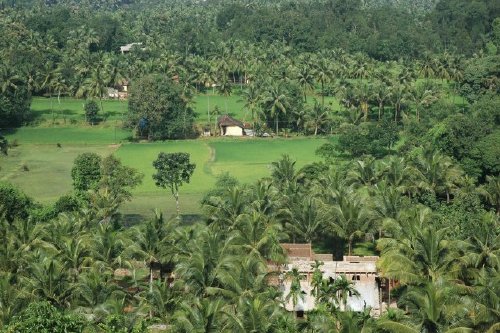 |
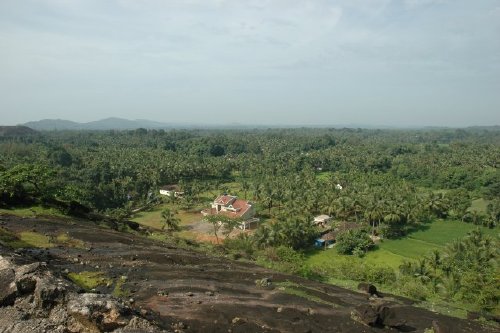 |
This is one of the most popular Jain pilgrimage center in South India, an is known for its colossal monolithic statue of Gomateswara, on top of a hill.
The temple to Gomateswara is built on top of a hill, in between two hills - at a height of 3000 feet above sea level. A flight of 500 steps provides access to this temple. Views of the neighborhood from the top of the hill are spectacular |
After climbing the steps ... albeit slowly ... I took this picture of the surrounding scenery. Looking at the house could be in almost any country in the world |
 |
|
The image of Gomateswara is an awe inspiring one. Carved out of a single block of granite, this 50 feet high statue, stands majestically on top of the hill. This image was created during the period of Chamundaraya, a minister of the Ganga King Rajamalla. |
This gigantic statue of lord Gomateswara, the Jain saint, is carved out of a single block of granite and stands majestically on top of a hill. For centuries, Sravanabelagola has remained a great Jain center and thousands of pilgrims flock to see the magnificent, gigantic statue of the Jain saint, Lord Gomateswara. The statue of Gomateswara shows the recluse completely nude, in the Jain custom. This statue of lord Gomateswara is 17m. (55 ft) high and is visible from a distance of 30km. |
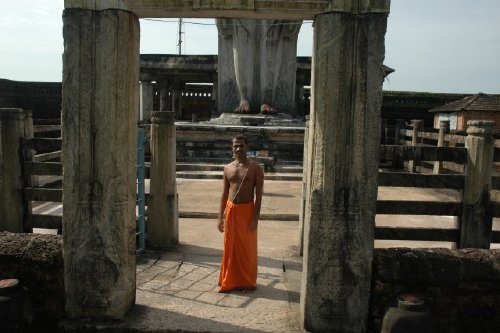 |
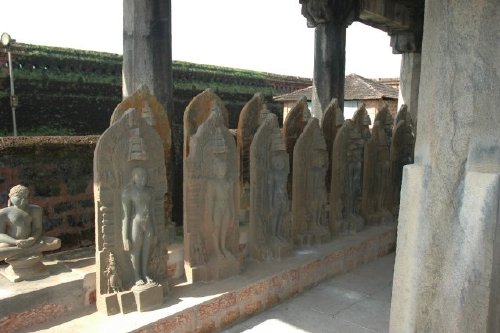 |
| A Jain Priest greeted everyone as they got to the top. |
In behind the statue were these incredibly carved mini statues |
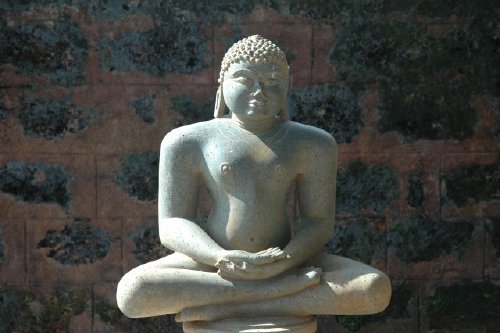 |
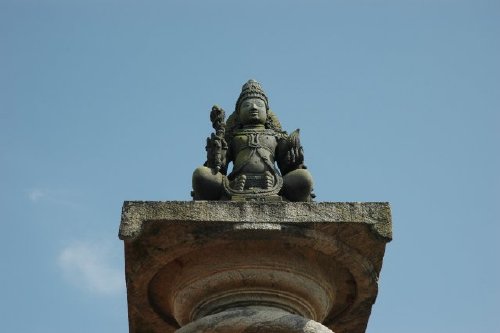 |
Lots of beautiful carvings were everywhere |
|
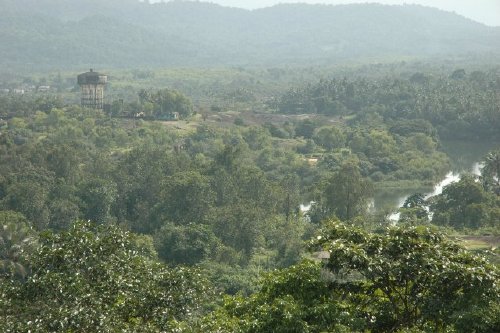 |
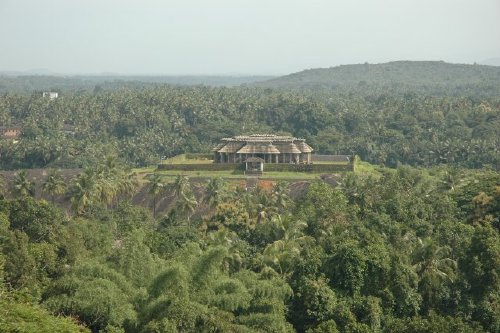 |
On the way down to the bus. It was hot as hell and the humidity was approaching 100%. Elsie was the smart one here. She stayed at the bottom talking with people. |
Another temple in the distance |
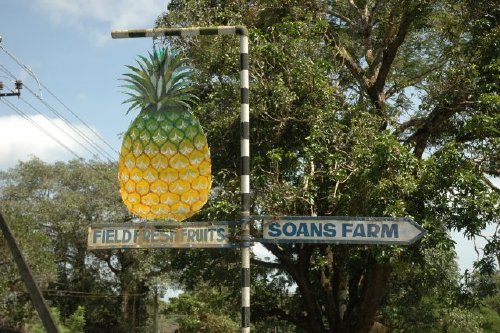 |
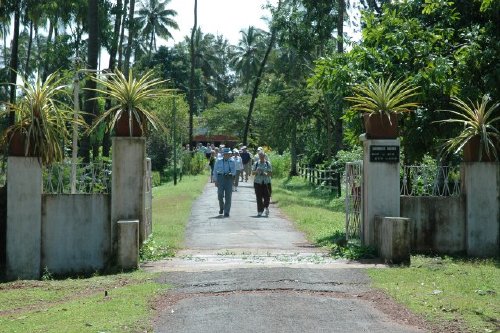 |
Soan's Farm, a spice and tropical fruit plantation, is located about 40 kms out of Mangalore. Doesn't sound far, but given the road conditions, it takes about 1 1/2 hours to travel this distance. As we got to the little store, they presented us with a glass of fresh pineapple juice That was GREAT! You can not get any fresher as it was pressed that morning. |
At present the farm is managed by the two sons of Alfred Soans, Dr. L.C. Soans, a Botanist who studied in the U.S.A. under a Fulbright grant and Mr. I.V. Soans, a fruit technologist by training. Horticultural development is further strengthened by a Nursery section and a Fruit processing plant. The cropping pattern has evolved into a multistoried mixed cropping, ecologically sustainable model, for visiting farmers from around the country. It has also become a popular destination for foreign tourists, to see the variety of spices and medicinal plants |
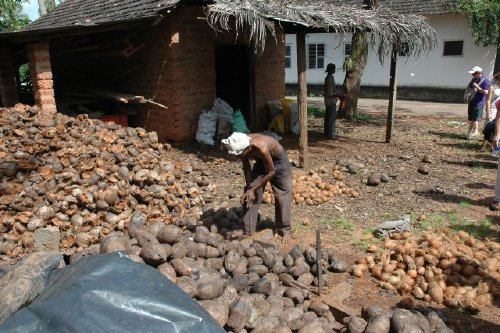 |
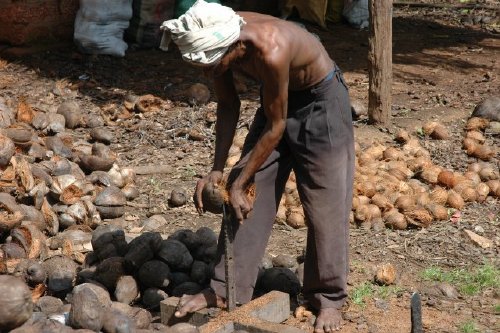 |
Worker husking coconuts. Everything is used from the husks to the coconut itself. |
A little concentration is required here!!! |
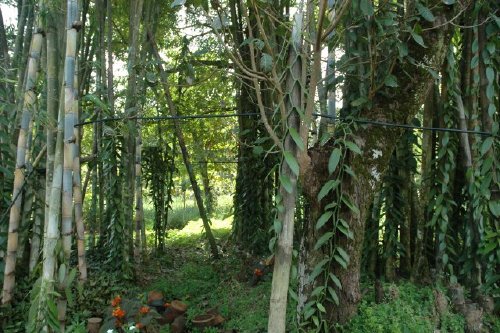 |
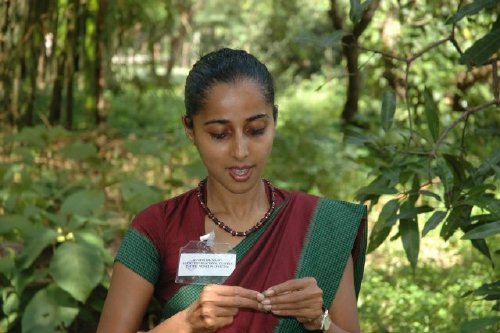 |
Giant Bamboo |
Here the guide picked an all spice leave |
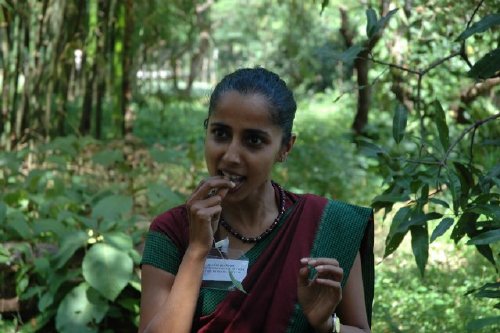 |
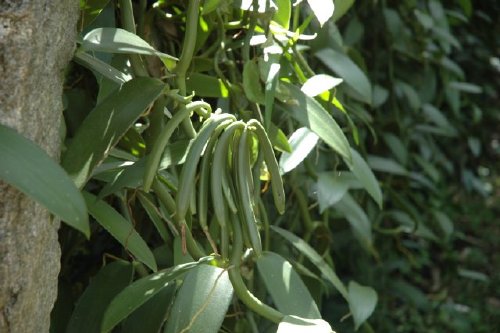 |
She had each one of us do the same and taste ... interesting .... |
Vanilla beans |
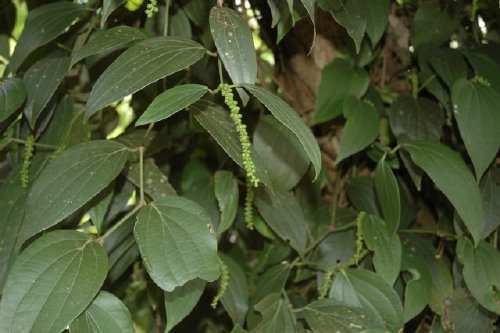 |
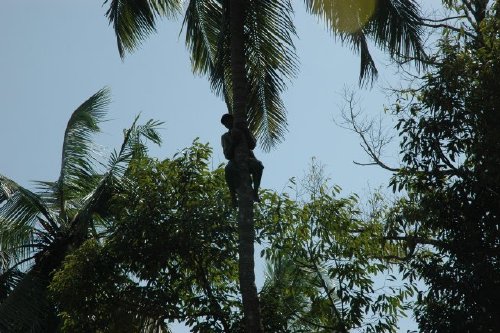 |
raw pepper |
One of the workers was climbing a coconut tree to trim the branches |
|
 |
| |
They grow a bit of everything here. |
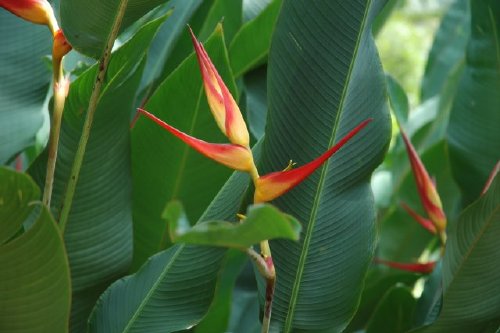 |
 |
From the Bird's of Paradise family |
The bus looks an awful lot better from the outside than on the inside. This tour was about 5 hours long with 3 of them driving. By this time, my back was threatening divorce!!! The seats were not designed for large people and were jammed so close together that comfort was just a word. |
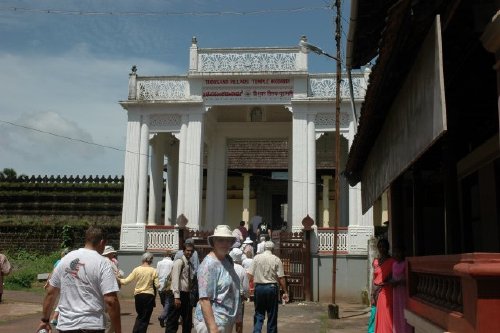 |
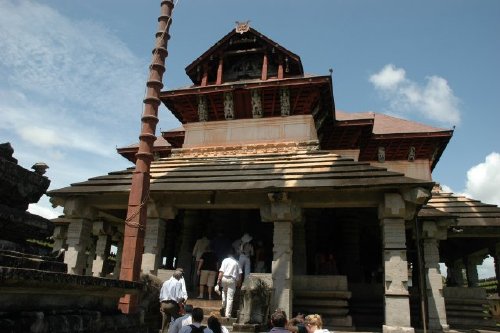 |
Temple of a Thousand Pillars was our next stop |
Thousand Pillar Temple : Constructed by Rudra Deva in 1163 AD, Thousand Pillar temple is a fine specimen of Kakatiya architecture and sculpture. The monument is built in the style of Chalukyan temples, situated near the Hanamkonda-Warangal highway, is a star shaped and triple shrine. The 3 shrines are dedicated to Lord Shiva, Vishnu and Surya. The temple is famous for its richly carved pillars, screens and detailed sculpture. The black basalt Nandi, a monolith, has a lovely polished finish. |
 |
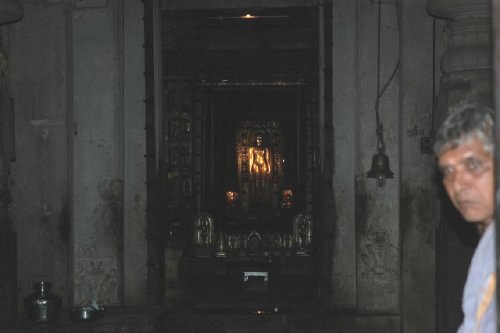 |
Elsie sure loves carved elephants ... Every time we saw one, I had to take a picture |
|
|
 |
The wall carvings sure stand out |
The ever present cow |
|
|
| |
|
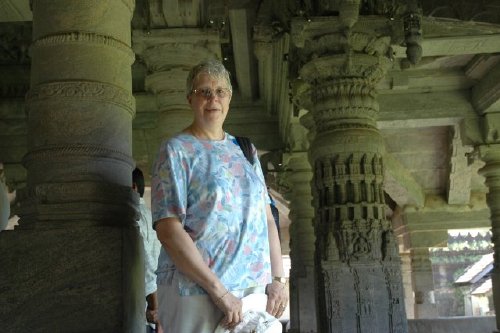 |
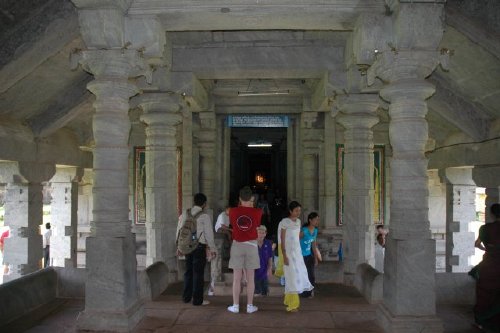 |
Does Elsie look frazzled here? Remember the heat .... |
Perched elegantly on the slopes of the hills at Hanmkonda, the Thousand Pillars Temples is a fine specimen of kakatiya architecture and sculpture. Built by Rudra Deva in 1163 AD in the Chalukyan style, the star-shaped, triple-shrined temple is dedicated to Shiva, Vishnu and Surya. The temple is notable for its richly carved pillar, perforated screens and exquisite icons, specially impressive are the rockcut elephants and the Nandi statue is reminiscent of a turbulent yet glorious history. The black basalt Nandi, a monolith, has a lovely polished finish. We were the only people visiting this Jain temple. It was totally silent, save for the wind that gently swayed the bells that hung from the peaks of the roof. |
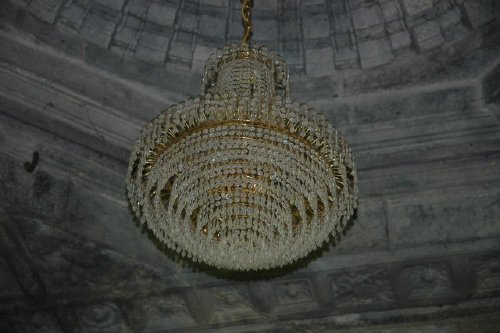 |
 |
Chandelier looks out of place in this context. |
Our next port of call was Phuket Thailand. This was one of the few stops that did not occur so early in the morning that we could either watch and take pictures or have breakfast. Guess which choice we made? |
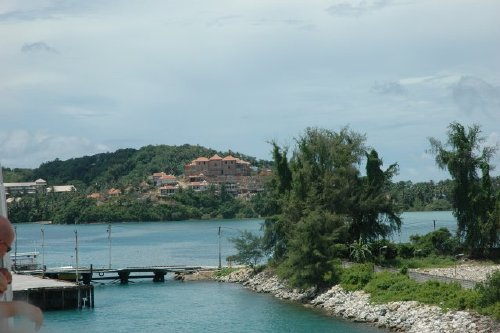 |
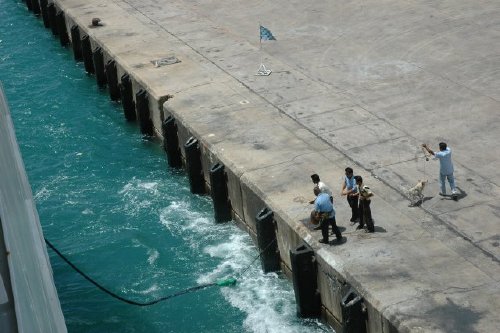 |
Actually it was a relatively small harbour for a ship of this size |
With the use of Bow Thrusters, the ship simply sails along side and then moves sideways to the dock. Here a little dog was chasing the line thrown from the ship to the shore workers. One of the few times we saw a dog that was being played with and not totally being ignored. This lack of pouch attention drove Elsie nuts. |
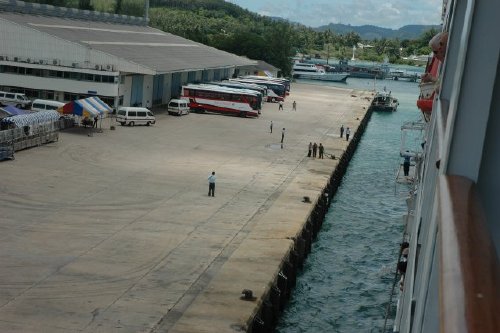 |
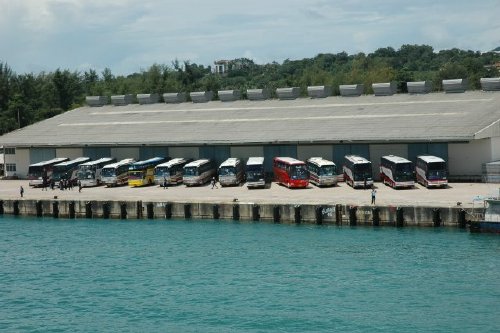 |
These shots were taken from our balcony |
Lots of tours leaving from this port. Princess has disembarkation down to a science. Each tour meets in one of the public rooms onboard where you have a tag stuck on your shirt over the left breast. Each tour has a different tag. Then the individual tours are called over the PA system to leave. Once on the quay, someone looks at your tag and directs you to the appropriate bus. Sort of fool proof eh? Someone always manages to screw it up ... much to the amusement of everyone. |
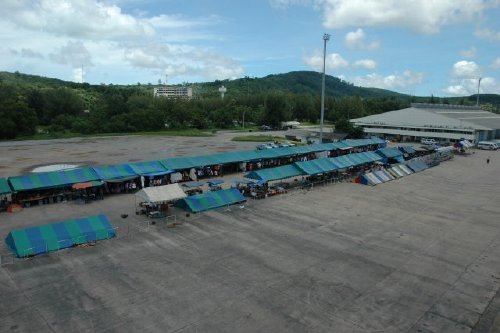 |
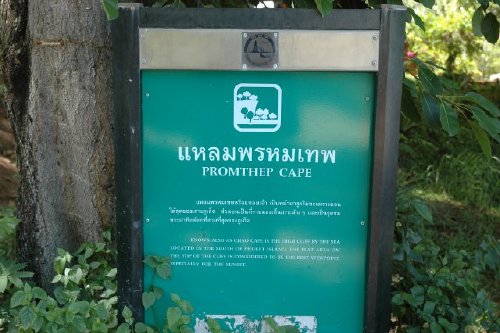 |
For those who were not booking a tour, there was the usual tacky tourist trash being sold right on the quay |
Our first stop was
Cape Promthep ‘Prom’ is the Thai word for the Hindu God ‘Brahma’ signifying purity and ‘Thep’ is Thai for God. Promthep is a headland stretching into the sea and forming the extreme south-end of Phuket Island. It has traditionally been the prominent feature for mariners approaching the island. |
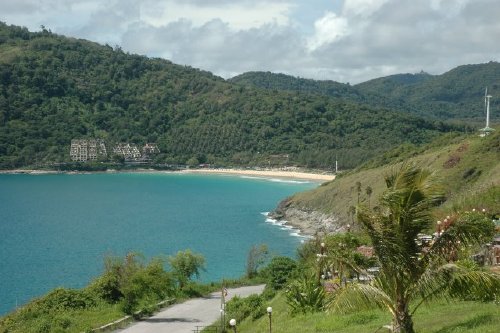 |
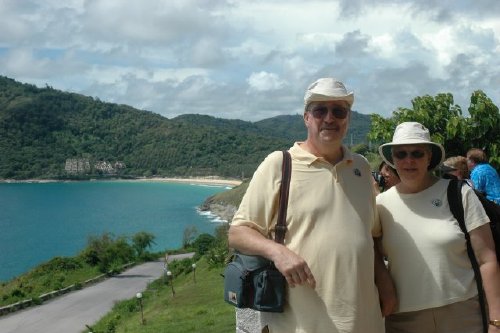 |
Views of the Andaman Sea |
Promthep Cape is the most southern tip of Phuket Island |
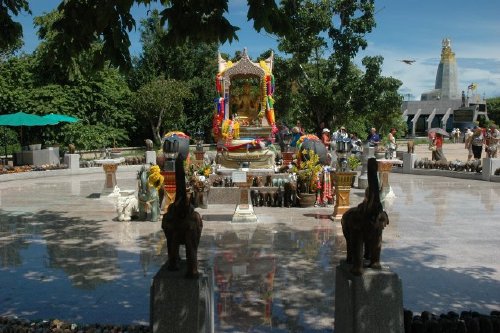 |
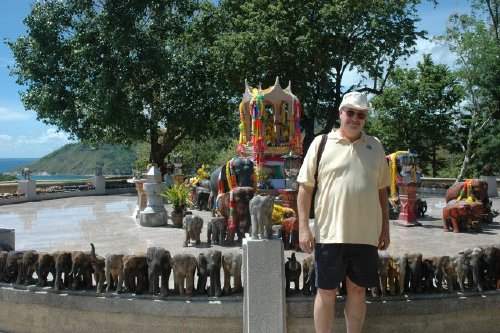 |
At the top is a shrine dedicated to Brahma, the Hindu god of creation, whom the cape is named after. (Phra Phrom is the Thai name for Brahma, laem means “cape”, while thep means “god”). To get an even better view, we climbed up a couple of flights of stairs to a raised platform in the Golden Jubilee Lighthouse. The lighthouse also contains a small nautical museum |
Quick ... can you pick out the elephant??? |
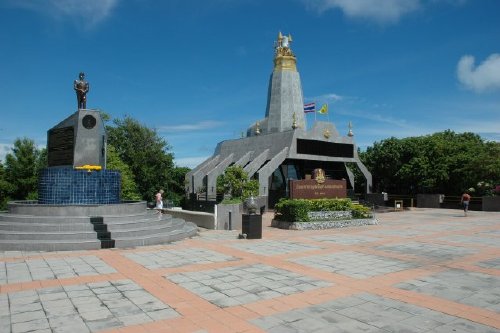 |
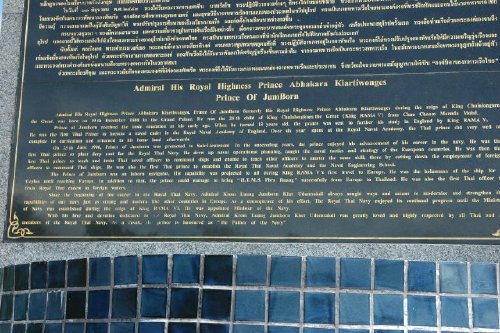 |
Golden Jubilee Lighthouse |
|
|
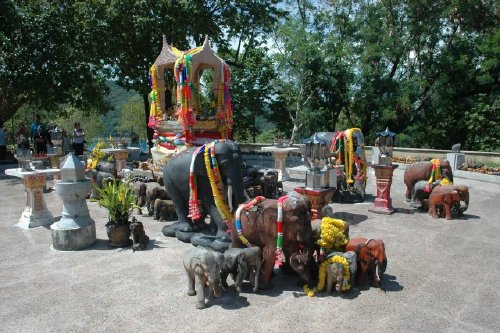 |
| Golden Jubilee Lighthouse |
A little elephant shrine |
 |
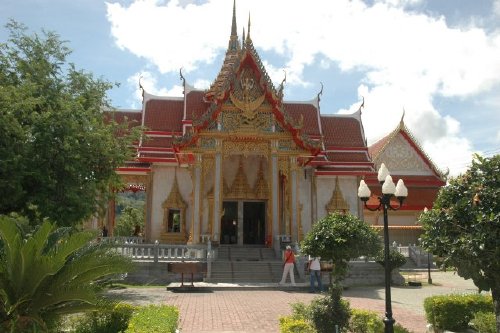 |
Again, Elsie goes nuts over elephants |
Our next stop was Wat Chalong, the biggest and most ornate of Phuket’s 29 Buddhist monasteries |
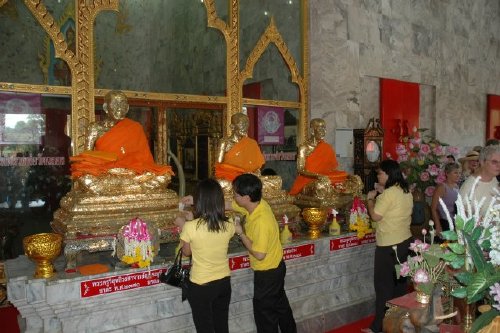 |
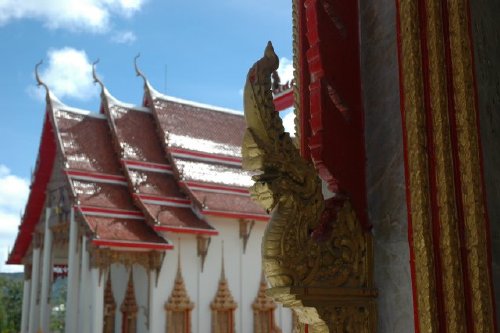 |
Wat Chalong is associated with the revered monks, Luang Pho Chaem and Luang Pho Chuang, both much revered by local people because of their role in quelling the miner rebellion in 1876 |
Typical Thai architecture at the roof ends. |
 |
|
Wat Chalong |
Wat Chalong |
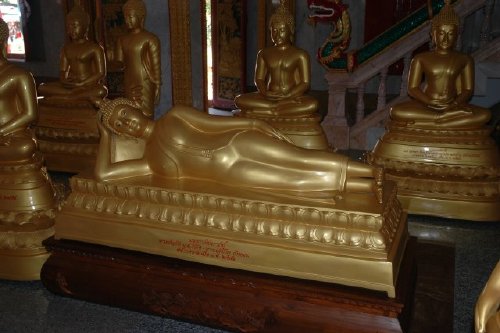 |
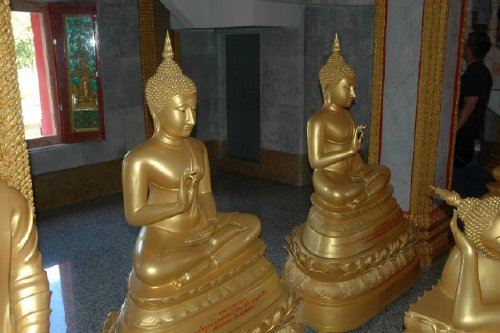 |
Wat Chalong |
Wat Chalong |
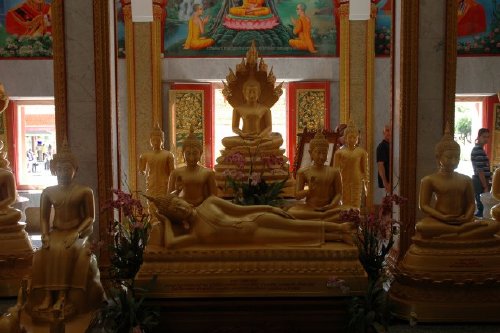 |
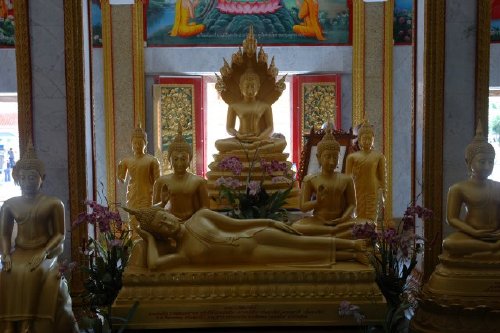 |
Wat Chalong |
Wat Chalong |
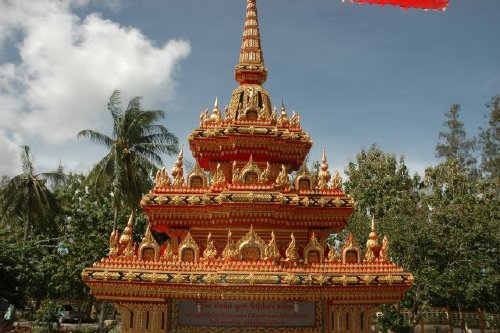 |
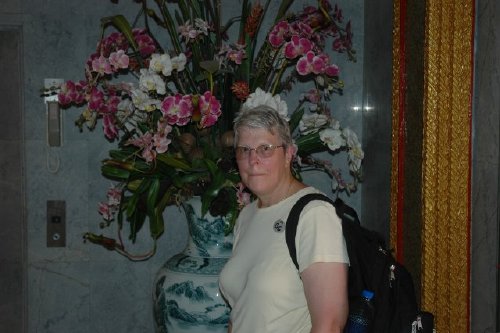 |
Wat Chalong |
Wat Chalong ... notice Elsie's shirt ... a constant state of sweat was enjoyed by all |
|
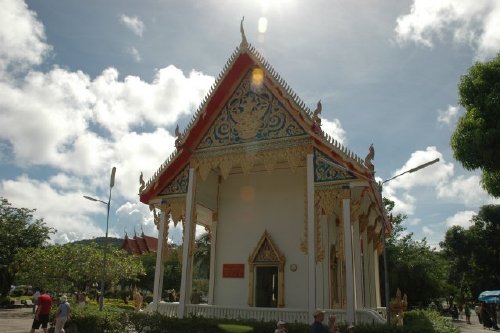 |
Wat Chalong |
Wat Chalong |
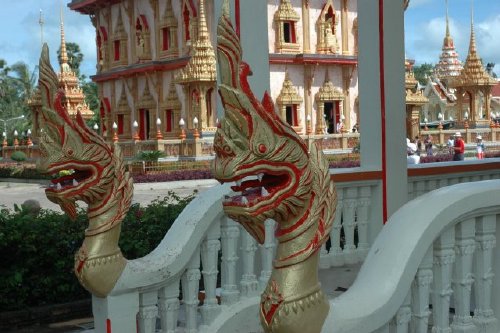 |
|
Wat Chalong |
Wat Chalong |
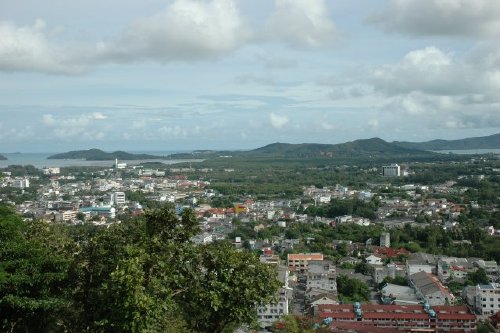 |
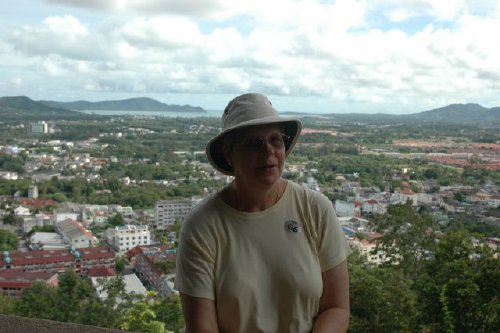 |
From the top of Rang Hill you can enjoy a superb of panorama of the offshore islands and southern part of Phuket Island |
Indiana Elsie again ... enjoying a rest |
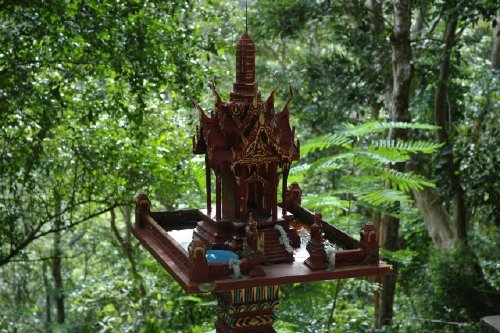 |
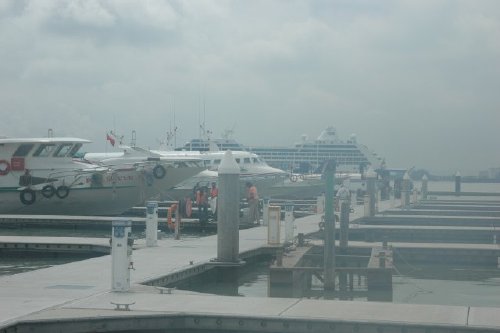 |
Lots of little family alters on posts at the side of the path to the lookout |
The ship's next stop was Penang Malaysia. We had been here on our last trip so we decided to forego an organized Princess tour. This was a port that the ship had to anchor in the harbour and then carry passengers ashore in the ships launches. Here you can see the boat and the yacht dock we landed at. |
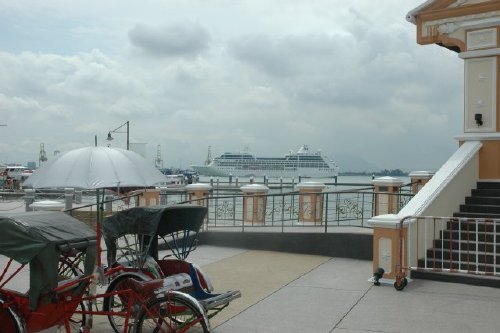 |
 |
A very clean city actually ... or is that reaction simply because we have now left India? Lots of Bicycle Rickshaws lining up. It was rather hard to walk past the street merchants to get off the dock. This pushy attitude of the street hawkers was a noticeable difference between India and here |
This was a restaurant we passed as we wandered around. Watch what you order being cooked seems to be the order of the day. |
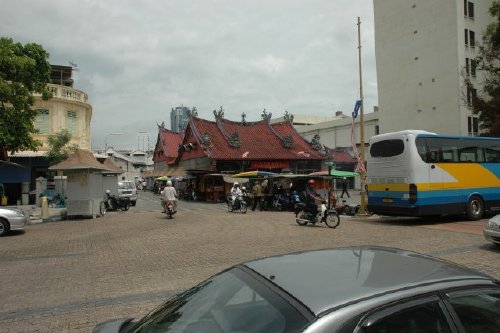 |
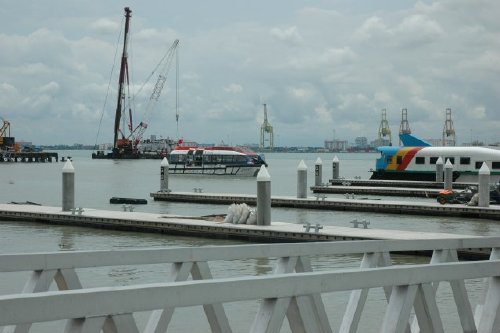 |
The traffic was not too bad and the city was very much a mixture of old and new |
Ahhh ... our Launch from the ship is arriving to take us back to A/C and lunch!!! |
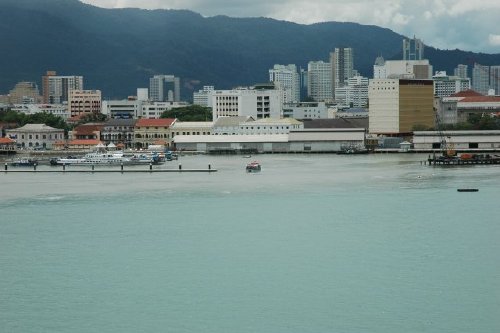 |
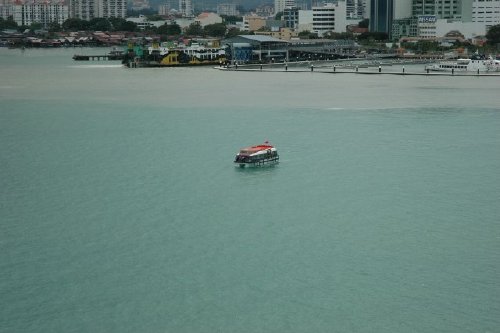 |
The harbour from our balcony. You can see the yacht dock where we landed. |
There were three launches (tenders) constantly ferrying people back and forth |
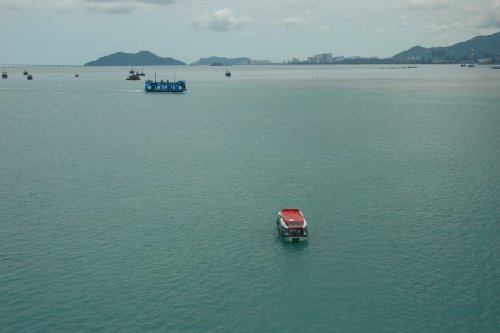 |
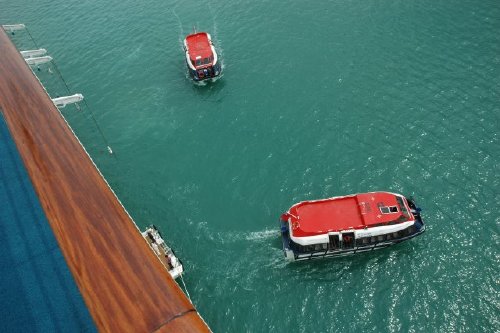 |
In the distance, you can see one of the local ferries. They have painted each one a different bright colour ... this one is the "Blue Ferry" |
Fortunately, it was very calm and getting on or off the boat was no problem. We have been on other cruises where this was not the case!!! This was a view from deck 11 ... the top deck of the ship. |
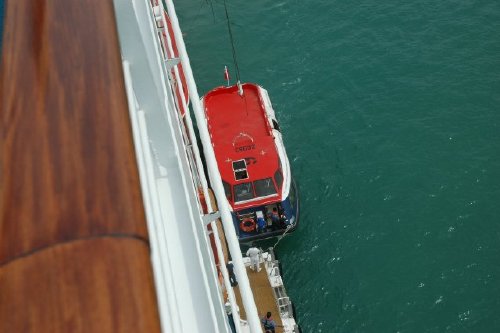 |
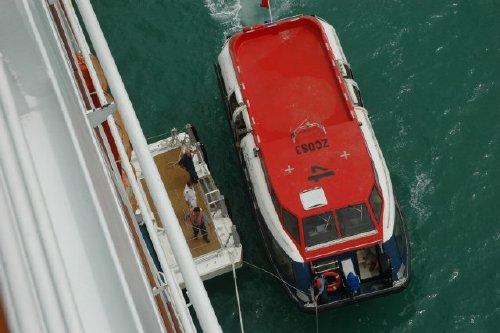 |
These launches sure are small when compared to the ship's size |
The crew seem to have fun when the ship has a tender port. |
 |
 |
Carrying to the Launch the freezer with the cold water and cool cloths that you get dock side. A very welcome custom!!! |
The Captain's Flying Bridge ... crew took advantage of the stop to do a little maintenance on the spot lights |
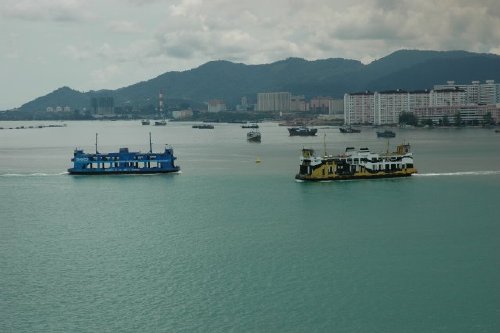 |
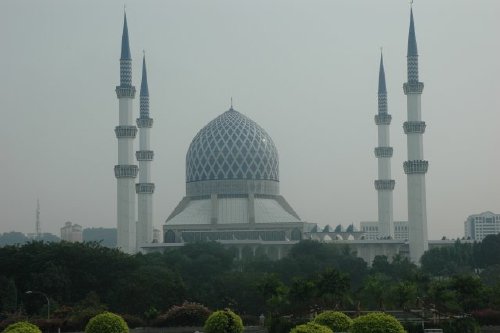 |
Here the "Yellow Ferry" passes the "Blue Ferry". They sure stand out. Perhaps we should think about doing the same thing with the Sea Bus here in North Vancouver? |
Our next stop on the Cruise was Kuala Lumpur Malaysia. Here we did do a Tour and it turned out to be quite interesting. Our first stop was the Masjid Sultan Salahuddin Abdul Aziz Mosque more familiarly known as the Blue Mosque |
 |
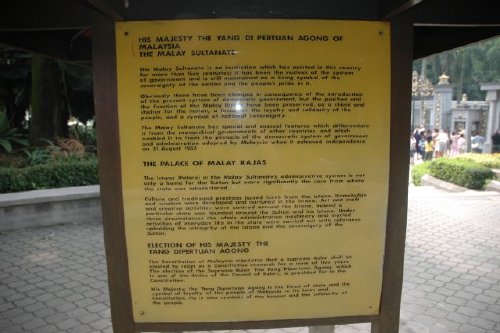 |
This is the state mosque os Selangor, Malaysia. and s the country's biggest. Construction began in 1982and finished on march 11th, 1988. The mosque can accommodate up to 24,000 worshippers. The main dome of the mosque is the biggest dome in Malaysia, measuring 170 feet in diameter and 350 feet in height from ground level. The four minarets are the second tallest in the world at 460 feet |
Our next stop in this tour was King’s Palace (Royal Palace) |
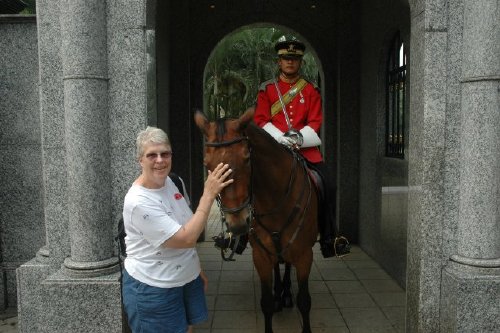 |
|
The Istana Negara is the official residence of His Majesty, the Yang di Pertuan Agong, the King of Malaysia. It stands on a 28-acre (11 hectare) area |
Looks a lot like Buckinham Palace in London eh? |
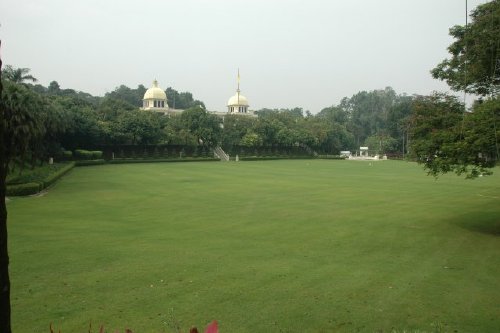 |
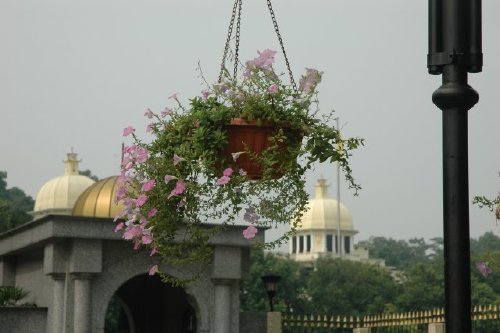 |
This is a huge spot! The grass is kept like the greens on a good golf course |
Flowers everywhere |
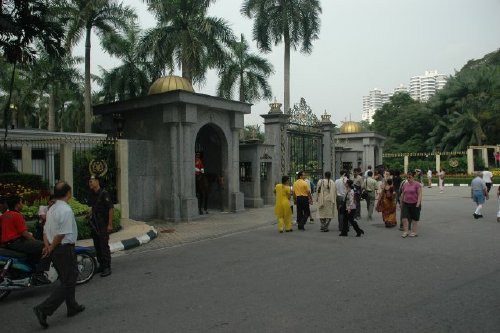 |
 |
Lot of similarities between here and London! |
Our next stop was the
the National Museum which contains exhibits of Malaysia's past and holds themed exhibits seasonally. Interestingly, there were exhibits from the stone age to present day, but there was absolutely no mention of the British period when they were in control of this region. Hmmmm???? |
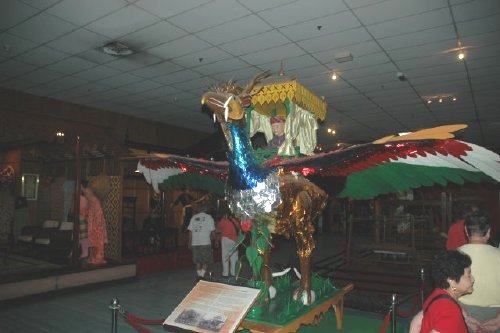 |
 |
This museum had a little bit of everything in it. Too much to take in given the little time the tour allocated to it. Yet another drawback to large organized tours. We sure missed the individual touch we enjoyed on our tours in India
|
Sure a classy bed eh ... |
 |
|
Lots of school trips to this site. Here Muslim girls are eating their lunch and the guys ere sitting about 20 yards away eating theirs. |
Kuala Lumpur has a impressive War Memorial in the down town area. |
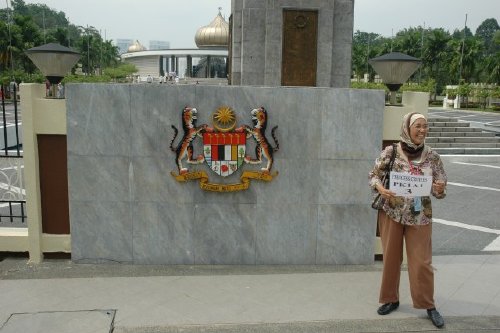 |
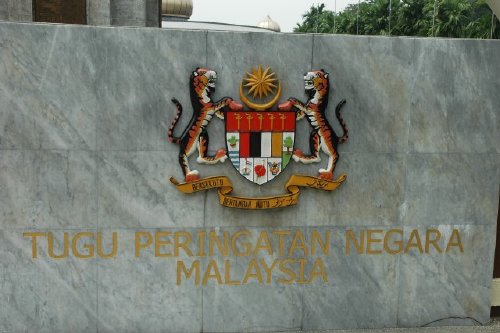 |
Our Guide explaining what the Memorial was all about |
|
 |
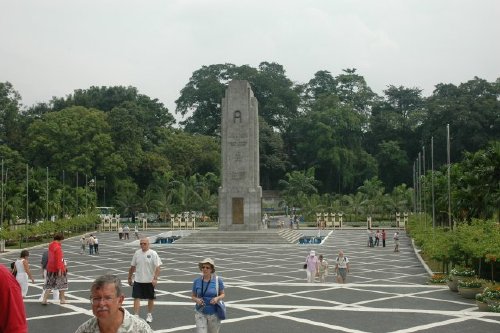 |
The famous KL Post Office Tower in the distance. It is world's fifth tallest telecommunication tower |
This was looking back at the entrance with our back to the even more famous Bronze Sculpture |
|
 |
The National Monument (Tugu Negara) commemorates those who died in Malaysia's struggle for freedom (principally against the Japanese occupation and during the Malayan Emergency) |
|
 |
 |
More school kids on an outing!!! They wanted to talk to everyone and show off their ability in English. |
The five-petaled Bunga raya (Hibiscus Rosa-Sinensis) has been Malaysia’s national flower since 1960. Symbolically, the five petals of the bunga raya represent the “Five Principles of Nationhood” – Malaysia’s national philosophy in strengthening national unity and tolerance -- while the red colour represents courage. The flower can be found throughout the country and parts of the Bunga raya’s shrub |
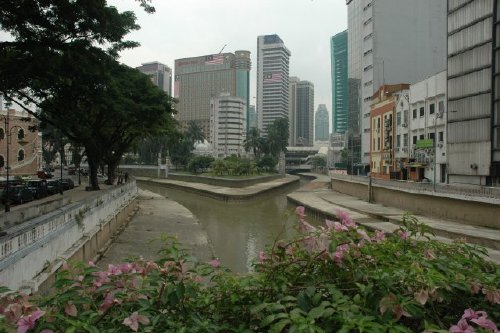 |
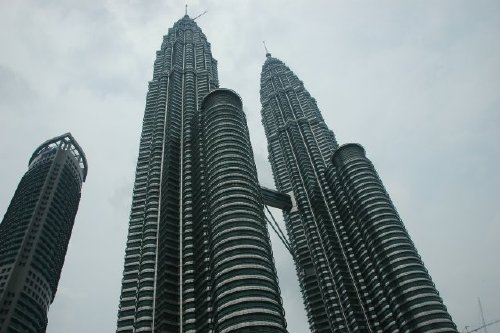 |
The junction of the Gombak and Klang rivers, from which Kuala Lumpur takes its name. In Malay, the name literally means "muddy confluence" |
The Petronas Twin Towers were the world's tallest twin towers and second and third-tallest singular towers, standing adjacent to one of the busiest shopping malls in Malaysia. Should I mention that it probably is a good thing that these towers are in a Muslim Country???? |
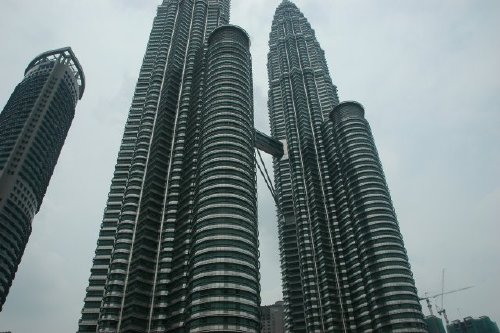 |
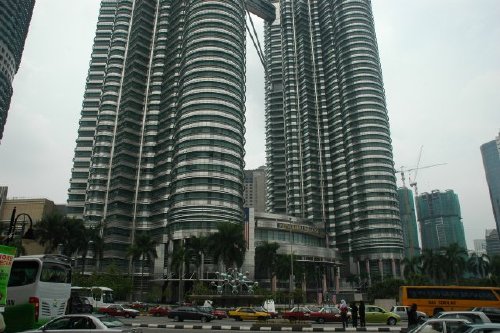 |
| The Petronas Towers have 88 floors and the connecting sky bridge is at the 42nd floor. |
Overall height 452 metres above street level Design/Architecture Cesar Pelli & Associates (USA) in association with KLCC architects Location of the sky bridge Levels 41 and 42 Length of the sky bridge 58.4 metres Heigth of the sky bridge 170 metres Vertical transportation 29 double-deck high speed passenger lifts in each tower Number of escalators 10 in each tower Stainless steel cladding 65,000 sq metres Vision glass 77,000 sq metres Concrete 160,00 cubic metres in the superstructures Steel 36,910 tonnes of beams, trusses and reinforcement Foundation 4.5 metres thick raft containing 13,200 cubic metres of grade 60 reinforced concrete, weighing approximately 32,550 tonnes under each tower, supported by 104 barette piles varying from 60 to 115 metres in length Total built-up area 341,760 sq metres Date of completion 1997 |
 |
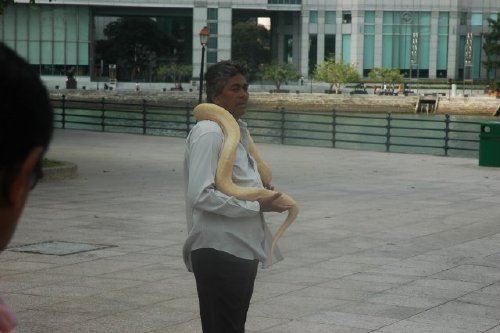 |
The next stop of the Cruise was Singapore. We had been here before, but we stupidly decided to do a cruise anyway. Included in the Tour was a river cruise that was really interesting. Here, we are at the dock for the river cruise and this clown is playing with an albino python. Just why people felt compelled to give him money escapes me!!! |
And for his next act ..... |
 |
 |
But, for the most part, they were ignored! |
Statue of Singapore's most famous resident, Sir Thomas Stamford Raffles (1781-1826), an agent of the British East India Company. He hoped to establish Singapore as a British port that could compete with the other Dutch ports in the region. He wanted to make Singapore a free port and an ideal stopping route for traders along the shortest sea route between India and China . |
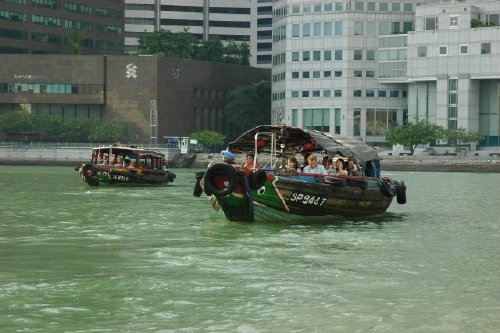 |
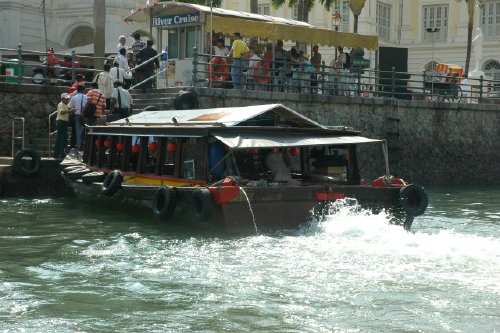 |
The River Cruise Boats |
The dock and people waiting to get on |
 |
 |
What they have done with the river sides is something that we should be doing with our harbour. It is spectacular |
All sorts of buildings but everything is, of course, extremely clean. |
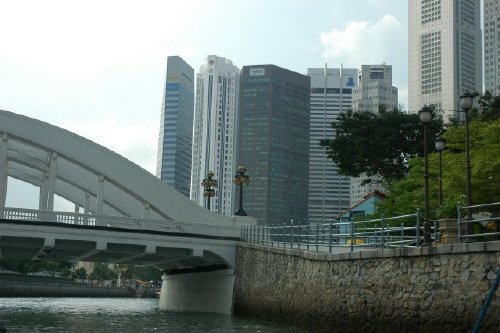 |
 |
This was Sunday Morning so there were not a lot of people out and about yet |
Restaurants, shops and apartments all line the shore |
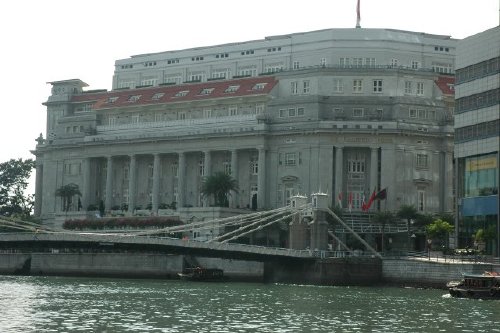 |
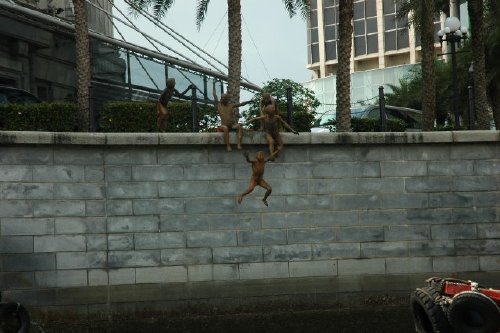 |
All time periods of architecture are represented |
This is a bronze sculpture and not really kids jumping, but it sure did look realistic! |
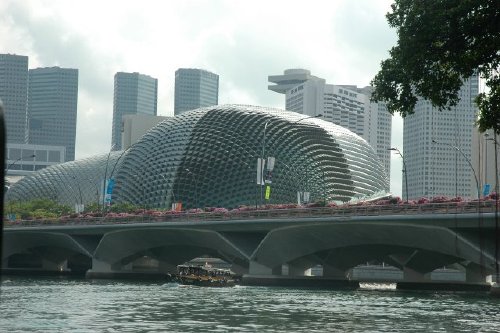 |
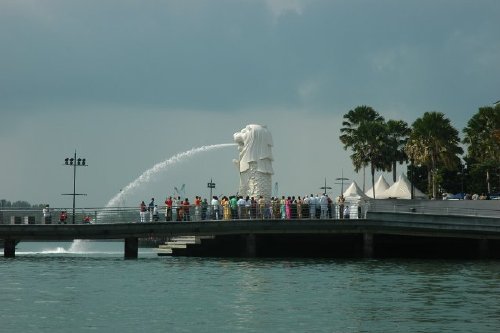 |
Esplanade - Theatres on the Bay is located on 6 hectares of prime waterfront land by Marina Bay . It is Singapore 's leading cultural entertainment and performing arts centre and is designed to meet the needs of a full-scale musical play. The Esplanade was first nicknamed The Papayas but later a new nickname The Durian stuck on and since then it has been fondly referred to as The Durian because of the prominent spiky sunshade curtain adorning the two glass domes of the complex. The Esplanade is a new generation of arts centre in Singapore |
Over the years, the Merlion symbol has become well-known through its wide use and has come to be identified with Singapore . |
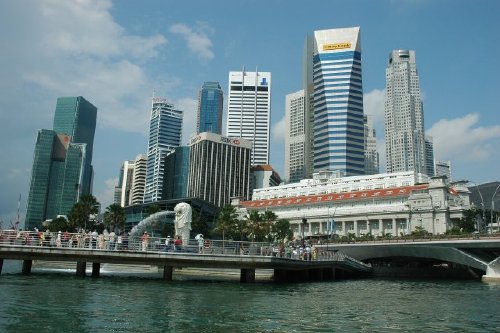 |
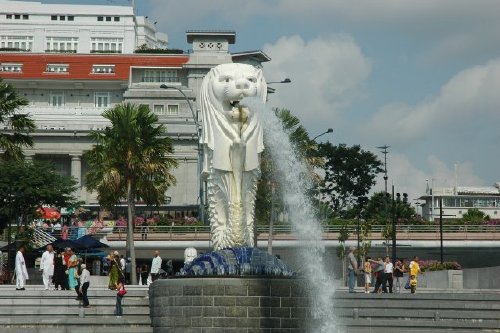 |
The Merlion from another angle. Interesting skyline eh? |
The Merlion has a lion head and a fish body resting on a crest of waves. The lion head symbolizes the legend of the rediscovery of Singapura, as recorded in the "Malay Annals". In ancient times, Singapore was known as Temasek, a Javanese word for sea. In the 11th century A.D, Prince Sang Nila Utama of the Sri Vijaya Empire rediscovered the island. When the Prince first landed on Singapore 's shores, he sighted a mystical beast which he later learnt was a lion. The Prince then decided to name the island "Singapura" which in Sanskrit means Lion (Singa) City (Pura). The fish tail of the Merlion symbolises the ancient city of Temasek and represents Singapore 's humble beginnings as a fishing village. |
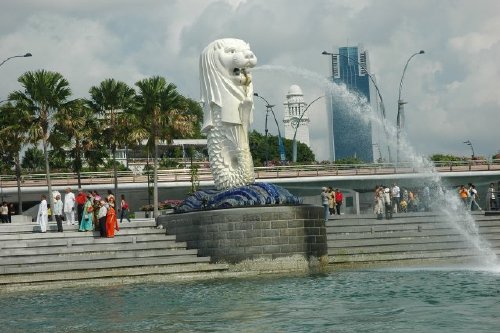 |
 |
The Merlion statue, measuring 8.6 metres high and weighing 70 tonnes, was built by the late Singapore craftsman, Mr Lim Nang Seng. It is made of cement fondue. A smaller Merlion statue, measuring two metres high and weighing three tonnes was also built by Mr Lim. The body is made of cement fondue, the skin from porcelain plates and eyes from small red teacups. |
Heading back to the dock |
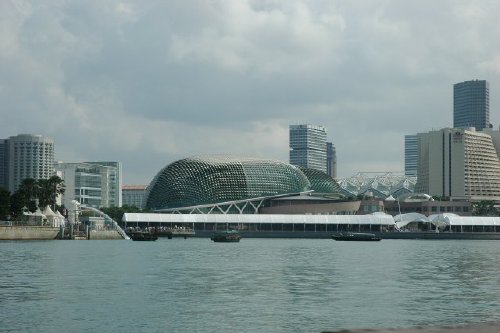 |
 |
Esplanade - Theatres on the Bay on our way back |
Every type of architecture know to man is represented here. |
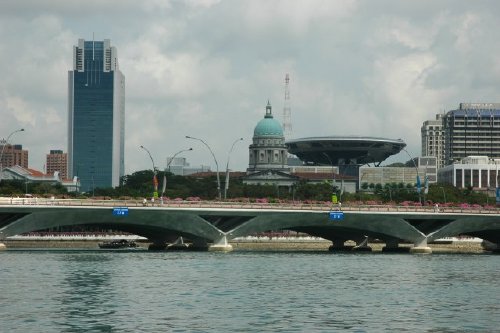 |
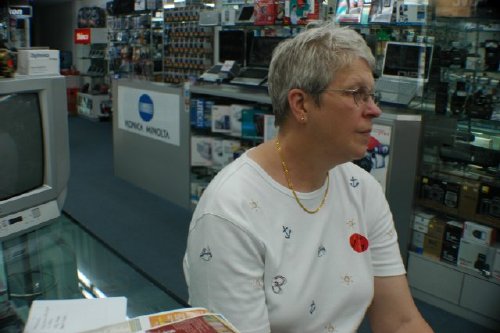 |
Interesting, Interesting city!!! |
The guide on this tour turned out to be so bad, that we jumped off the tour just as soon as we could and headed to China Town ourselves. We headed straight to a camera shop and Elsie went wild .. new digital camera and all the trimmings and a new Palm Pilot. I got a Tee Shirt. |



